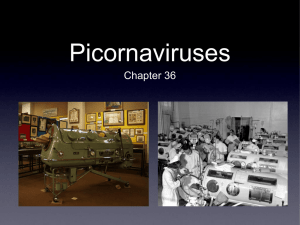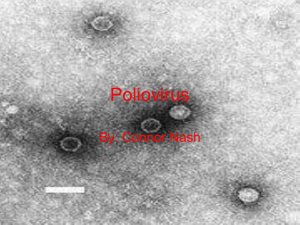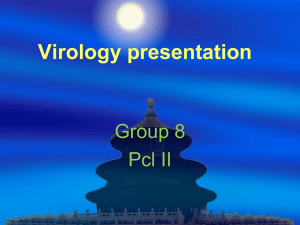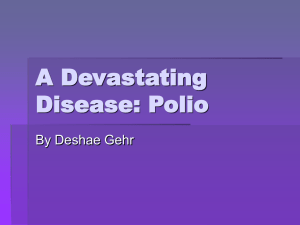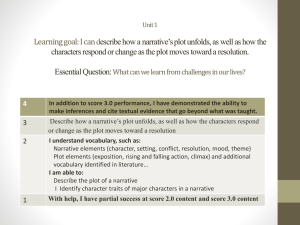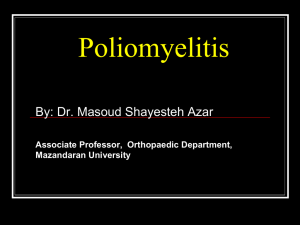National Poliomyelitis Response Plan for New
advertisement
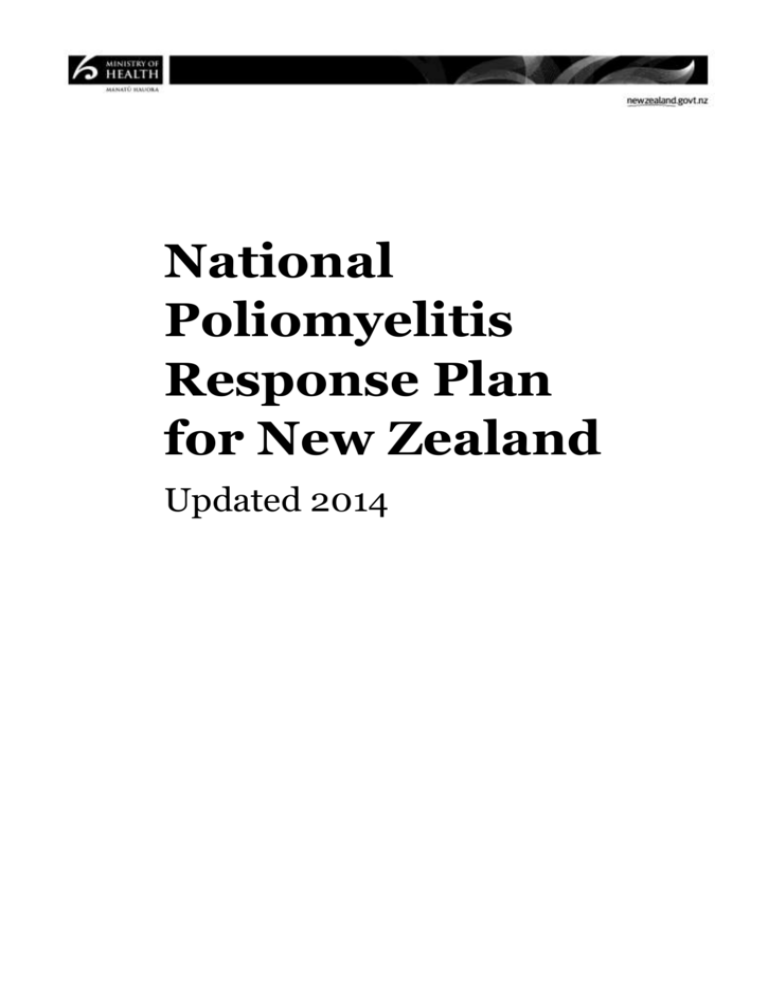
National Poliomyelitis Response Plan for New Zealand Updated 2014 Citation: Ministry of Health. 2014. National Poliomyelitis Response Plan for New Zealand: Updated 2014. Wellington: Ministry of Health. First published in May 2009, updated September 2014 by the Ministry of Health PO Box 5013, Wellington 6145, New Zealand ISBN 978-0-478-42883-4 (online) HP 5981 This document is available at www.health.govt.nz This work is licensed under the Creative Commons Attribution 4.0 International licence. In essence, you are free to: share ie, copy and redistribute the material in any medium or format; adapt ie, remix, transform and build upon the material. You must give appropriate credit, provide a link to the licence and indicate if changes were made. Acknowledgements The Ministry of Health gratefully acknowledges the assistance of the members of the National Certification Committee for the Eradication of Polio in the drafting of this Plan: Professor Steve Chambers (Chair), Associate Professor Nigel Dickson, Dr Lesley Voss, Dr Patrick O’Connor, Dr Fran McGrath, Dr Sue Huang, Dr Cia Sharp, and Ms Amanda Phillips providing secretarial support. National Poliomyelitis Response Plan for New Zealand iii Glossary Term Definition acute flaccid paralysis (AFP) A clinical manifestation characterised by sudden onset of weakness or paralysis and reduced muscle tone. inactivated polio vaccine (IPV) A vaccine that is injected and works by producing protective antibodies in the blood, thus preventing the spread of poliovirus to the central nervous system. However, it induces only very low levels of immunity to poliovirus locally, inside the gut. IPV provides individual protection against polio paralysis but, unlike OPV, has unknown efficacy against asymptomatic infection and the subsequent spread of poliovirus. oral polio vaccine (OPV) A polio vaccine with a two-pronged action. OPV produces antibodies in the blood to all three types of poliovirus. In the event of infection, this will protect the individual against polio paralysis by preventing the spread of poliovirus to the nervous system. OPV also produces a local immune response in the lining (mucous membrane) of the intestines, the primary site for poliovirus multiplication. The antibodies limit the multiplication of ‘wild’ (naturally occurring) virus inside the gut, preventing effective infection. This intestinal immune response to OPV is probably the main reason why mass campaigns with OPV can rapidly stop person-to-person transmission of wild poliovirus. vaccine-associated paralytic poliomyelitis (VAPP) VAPP is a rare event, where neurological damage is caused by a virus ingested from the OPV. A mutation of the vaccine virus, known as a reversion, causes previously attenuated poliovirus to revert to a more neuro-virulent form (VDPV). The paralysis that results is identical to that caused by wild poliovirus. vaccine-derived poliovirus Vaccine-derived poliovirus is the live, attenuated strain of the (VDPV) poliovirus contained in the OPV that has changed and reverted to a form that can cause paralysis in humans and has the capacity for sustained circulation. Vaccine-derived polioviruses differ from the parental (original) Sabin strains found in the vaccine by 1% to 15% of VP1 nucleotides. This is a measure of genetic change that scientists use to monitor the circulation of viruses. wild poliovirus iv The naturally occurring poliovirus. Polioviruses with greater than 15% sequence difference in the VP1 coding region are defined as wild polioviruses. National Poliomyelitis Response Plan for New Zealand Contents Acknowledgements iii Glossary iv Key points vi 1 2 3 4 Introduction 1 1.1 Purpose of this plan 1 1.2 Current situation 1 1.3 Likely paralytic polio case scenario 2 Background 3 2.1 Case definition of polio 3 2.2 The spread of poliovirus 4 2.3 Polio vaccines currently in use in New Zealand 5 Case response 6 3.1 Notification 6 3.2 Laboratory investigation 6 3.3 Methods of laboratory testing for poliovirus 7 3.4 Management of cases 9 3.5 Community response 10 Contact response 11 4.1 11 Contacts 5 Community measures 14 6 Appendices 15 Appendix 1: Virus laboratory contact details 15 Appendix 2: Instructions for sending samples to ESR 16 List of Figures Figure 1: Laboratory flow diagram for a suspected polio case National Poliomyelitis Response Plan for New Zealand 8 v Key points Poliovirus is still endemic in a number of countries. Afghanistan, Nigeria and Pakistan have never been declared free of polio, and between January 2013 and May 2014 wild poliovirus was re-introduced into a number of countries, including Cameroon, Egypt, Ethiopia, Equatorial Africa, Iraq, Israel, Kenya, Syrian Arab Republic and Somalia. From January to May 2014, there was international spread of wild poliovirus in central Asia (from Pakistan to Afghanistan), in the Middle East (Syrian Arab Republic to Iraq) and in Central Africa (Cameroon to Equatorial Guinea). As part of the declaration of polio as a Public Health Emergency of International Concern by the World Health Organization (WHO) in May 2014, Cameroon, Pakistan and the Syrian Arab Republic were identified as being at the greatest risk of exporting cases. New Zealand has been declared polio free, with the last case occurring in 1977. In New Zealand, 93 percent of children under one year of age are fully immunised. As part of the WHO initiative to eradicate polio, New Zealand has a programme of surveillance and investigation of all cases of acute flaccid paralysis in children under the age of 15. Polio is caused by wild poliovirus types 1, 2 and 3, or by live vaccine-derived poliovirus. The polio virus is passed person to person, with a usual incubation period of 7–14 days. All people suspected of suffering from polio should be notified immediately to the local medical officer of health and appropriately investigated. Laboratory investigations should be discussed with the local virologist/microbiologist, who will liaise with the WHO-accredited National Poliovirus Reference Laboratory at ESR.1 The risk level of contacts should be considered and appropriate investigations undertaken. A single case of polio will not necessarily require extensive community vaccination. 1 Institute of Environmental Science and Research Limited. vi National Poliomyelitis Response Plan for New Zealand 1 Introduction 1.1 Purpose of this plan This plan sets out the response required in New Zealand to a case of probable and/or confirmed poliomyelitis (polio) caused by a wild-type poliovirus or by a vaccine-derived poliovirus (VDPV). It complements the chapter on poliomyelitis in the Ministry of Health’s Communicable Diseases Manual 2012 by providing more detail. Note that a ‘probable’ case is a clinically compatible illness with an epidemiological link to a case of polio. 1.2 Current situation Worldwide, 406 cases of polio were reported to the WHO in 2013, an increase from 223 in 2012. In 2013, polio remained endemic in Afghanistan (14 cases), Nigeria (53 cases) and Pakistan (93 cases), and new cases were reported from Somalia (194), Syria (25), Ethiopia (9), Cameroon (4) and Kenya (14). In 2014, up to mid-May, cases continued to be reported in Afghanistan (4), Nigeria (3) and Pakistan (66), and also in Equatorial Guinea (3), Iraq (1), Cameroon (3), Syria (1) and Ethiopia (1).2 More information on polio and the polio situation is available on the Polio Global Eradication Initiative website: www.polioeradication.org/Home.aspx All countries remain at risk of importing polio, especially in the ‘poliovirus importation belt’ of countries stretching from West Africa to the Horn of Africa. The last case of wild poliovirus in New Zealand was in 1977, and the WHO Western Pacific Region has been declared polio free since 2000. Although vaccine-associated paralytic polio (VAPP) was documented in New Zealand after 1977, none have occurred since the inactivated polio vaccine (IPV) was introduced in 2002. Nevertheless, there is a risk of imported cases, as happened in Australia in 2007, when an Australian citizen with family in Pakistan returned from there with the virus and developed paralytic polio.3 New Zealand needs to be ready with a prompt, effective and evidence-based response if a case is imported. In New Zealand, in the 12-month period to the end of December 2013, 93 percent of children were fully immunised (including three doses of IPV) by one year of age. Vaccine coverage at one year of age has been over 85 percent since 2009, so if poliovirus was introduced into New Zealand it is unlikely to spread significantly among young children, but it could spread among other age groups or poorly immunised communities. 2 www.polioeradication.org/Infectedcountries/PolioEmergency.aspx 3 This is classified as a Pakistan case because the infection occurred there. National Poliomyelitis Response Plan for New Zealand 1 1.3 Likely paralytic polio case scenario The most likely scenario for a local polio case is similar to that experienced by Australia, where a person is infected by wild poliovirus in an endemic country and then enters New Zealand. Other scenarios, albeit of extremely low probability, include: importation of VDPV following travel to an area where the virus is known to be circulating importation of a case of VAPP from a country using oral polio vaccine (OPV) importation of wild poliovirus from a country with recent cases of non-endemic polio exposure to wild polio in a laboratory.4 If a polio case is detected in New Zealand, the Ministry of Health will carry out a risk assessment and will seek expert advice from the National Certification Committee for the Eradication of Polio about potential additional public health measures to ensure no further transmission occurs. 4 2 No New Zealand laboratory knowingly holds wild poliovirus, but laboratory exposure could occur through contact with specimens not known to contain wild poliovirus. National Poliomyelitis Response Plan for New Zealand 2 Background 2.1 Case definition of polio Clinical description Poliomyelitis (polio) is caused by wild poliovirus types 1, 2 and 3 or by live, vaccine-derived poliovirus. Infection is established in the gastrointestinal tract. A minor illness (fever, malaise, headache, vomiting) occurs in about 10 percent of infections. Over 90 percent of infections are asymptomatic or involve non-specific fever. In a minority of cases (less than 1 percent), infection spreads to the central nervous system and is characterised by: having no other apparent cause acute flaccid paralysis (AFP) of one or more limbs, with decreased or absent deep tendon reflexes in affected limbs no sensory or cognitive loss a possible effect on bulbar muscles. In children who develop paralysis, the illness may be biphasic, with the initial phase of a mild febrile illness of one to three days’ duration indistinguishable from that of many other viral infections. The child appears to recover, only to be struck down abruptly two to five days later with meningism, followed by paralysis. In adults and adolescents, the illness usually presents with a gradual onset of paralysis and muscular pain without the early symptoms. Laboratory test for diagnosis Laboratory confirmation requires the isolation of poliovirus or the detection of poliovirus nucleic acid from a clinical specimen. Different types of poliovirus will need to be tested for depending on the type of polio suspected (for example, wild poliomyelitis or vaccine-associated strains). See Section 3 for details of what specimens to collect. All testing of specimens for poliovirus must be undertaken in a laboratory accredited by the WHO. The WHO-accredited National Poliovirus Reference Laboratory at ESR is accredited for poliomyelitis testing. ESR tests for poliovirus using polymerase chain reaction (PCR), with a turnaround time of 48 hours, and by viral culture with a turnaround time of 10 days. Contact ESR and refer to Appendix 2 for specific advice on specimens required and on packing and transporting the specimens: WHO-accredited National Poliovirus Reference Laboratory Institute of Environmental Science and Research National Centre for Biosecurity and Infectious Disease Wallaceville Science Centre Phone: (04) 529 0606 After hours: 027 216 7833 66 Ward Street Wallaceville, Upper Hutt 5018 New Zealand PO Box 40158 Upper Hutt 5140 New Zealand National Poliomyelitis Response Plan for New Zealand 3 Case classification Cases are classified into the following categories: under investigation—a case that has been notified, but information is not yet available to classify it as probable or confirmed probable—a clinically compatible illness with an epidemiological link confirmed—a clinically compatible illness that is laboratory confirmed not a case—a case that has been investigated and subsequently found not to meet the case definition, including cases under the age of 15 years that have been deemed to have a nonpolio paralytic illness by the National Certification Committee for the Eradication of Polio. Cases can be further classified as follows. Vaccine-associated paralytic poliomyelitis (VAPP): a rare event where neurological damage is caused by a virus ingested from the oral polio vaccine (OPV). A mutation of the vaccine virus, known as a reversion, causes previously attenuated poliovirus to revert to a more neuro-virulent form. The paralysis that results is identical to that caused by wild poliovirus. Wild virus-associated poliomyelitis: any case not meeting the criteria for being vaccine associated. Such cases will be imported, since New Zealand was declared free of poliomyelitis by the WHO in 2000. Imported: a case occurring in a person who has travelled or resided in a polio-endemic area within 30 days of disease onset, or who is epidemiologically linked to a person who has done so. Surveillance should be intensified at both the local and national levels to detect any additional cases without delay. Vaccine-derived poliomyelitis infection (VDPV): vaccine-derived poliovirus is the live, attenuated strain of the poliovirus contained in the OPV that has changed and reverted to a form that can cause paralysis in humans and has the capacity for sustained circulation. Vaccine-derived polioviruses differ from the parental (original) Sabin strains found in the vaccine by 1 to 15 percent of VP1 nucleotides. This is a measure of genetic change that scientists use to monitor the circulation of viruses. 2.2 The spread of poliovirus Mode of transmission Poliovirus is passed person to person, principally via the faecal–oral route, but potentially also via respiratory droplets. Incubation period The incubation period for polio is usually 7–14 days for infections resulting in AFP, although the reported range is 3–35 days. 4 National Poliomyelitis Response Plan for New Zealand Period of communicability The period of communicability of the poliovirus has not been precisely defined, but transmission is possible as long as the virus is excreted. Poliovirus has been detected in throat secretions as early as 36 hours, and in faeces 72 hours, after exposure to infection. It typically persists in the pharynx for about one week and in faeces for three to six weeks. However, it may be shed in the faeces of immunocompromised people for several years. Cases are most infectious in the days immediately before and after the onset of any symptoms. 2.3 Polio vaccines currently in use in New Zealand The New Zealand immunisation schedule involves a course of four doses of polio vaccine given at six weeks, three months, five months and four years using INFANRIX®-hexa (a hexavalent vaccine containing DTaP-IPV-HepB/Hib) for the first three doses, and INFANRIX™-IPV (a tetravalent vaccine containing DTaP-IPV) for the fourth dose.5 Further information is available in the Ministry of Health’s Immunisation Handbook 2014. 5 Ministry of Health. 2014. Immunisation Handbook 2014. Wellington: Ministry of Health. URL: www.health.govt.nz/publication/immunisation-handbook-2014. A more recent version may be available on the website. National Poliomyelitis Response Plan for New Zealand 5 3 Case response 3.1 Notification All people suspected of suffering from polio must be notified to the medical officer of health by the clinician caring for the patient, and they must be appropriately investigated. Laboratories must immediately notify the local medical officer of health of any polio-positive VP1-based sequencing, and the medical officer of health must then immediately inform the Director of Public Health at the Ministry of Health. There should be a higher index of suspicion if there is clinically compatible illness with an epidemiological link.6 The medical officer of health should ensure that the New Zealand Paediatric Surveillance Unit has also been notified (see below). The local medical officer of health is responsible for ensuring adequate isolation of the case after hospital discharge, and identification and management of the case contacts. Under the WHO’s International Health Regulations 2005 (IHR), assessment of any suspected case of poliomyelitis must occur within 48 hours of initial identification, and any isolation of wild poliovirus must then be notified to the WHO via the National Focal Point within 24 hours of confirmation. This confirmation must have been undertaken by the WHO-accredited National Poliovirus Reference Laboratory at ESR. In New Zealand, the National Focal Point is the Office of the Director of Public Health. As part of the WHO initiative to eradicate polio, New Zealand has a programme of surveillance and investigation of all cases of AFP in children under the age of 15. Such cases are required to be reported by telephone to the New Zealand Paediatric Surveillance Unit at the Department of Women’s and Children’s Health, University of Otago, Dunedin, and to have a full clinical and epidemiological assessment and virological investigation of stool specimens. All cases are discussed by the National Certification Committee for the Eradication of Polio, and records of its deliberations are reported to the WHO. 3.2 Laboratory investigation The case should be urgently discussed with the local virologist/medical microbiologist, who might discuss the case with the WHO-accredited National Poliovirus Reference Laboratory at ESR. It is important to ascertain the presence or absence of poliovirus as quickly as possible. 6 6 An epidemiological link is defined here as a history within the past 35 days of one or more of (a) travel to high-risk countries (wild poliovirus-endemic countries, see www.polioeradication.org/casecount.asp for an up-to-date list), (b) exposure to high-risk individuals (a person with polio infection, a person immunised with OPV within the last two months, a person with a history of travel to high-risk countries within the last three months, a recent recipient of OPV, or a person working with poliovirus in a laboratory), (c) exposure to poliovirus in a laboratory. National Poliomyelitis Response Plan for New Zealand The following specimens should be collected and transported to the local laboratory as soon as possible: two stool samples collected 24 hours apart within 14 days’ onset (or rectal swab with faecal material if stool is not immediately available) cerebrospinal fluid a nasopharyngeal swab or throat swab EDTA blood serum. Stools, cerebrospinal fluid, nasopharyngeal swab or throat swab, or EDTA blood can be used for the enterovirus polymerase chain reaction (PCR) test. Stools are suitable for poliovirus isolation. Serum is suitable for detecting polio-neutralising antibodies. All children with AFP should have two stool samples (or rectal swab with faecal material if stool is not immediately available) collected 24 hours apart within 14 days onset of the paralysis. These should be sent to ESR via the local laboratory, as per current AFP surveillance. See Appendix 2 for instructions on sending specimens to ESR. 3.3 Methods of laboratory testing for poliovirus The sequence of testing shown in Figure 1 should be undertaken on all suspected polio cases. The tests progress from the least specific, which can be undertaken at all virus laboratories, to the most specific, which need to be done by the WHO-accredited National Poliovirus Reference Laboratory at ESR. Any reporting to WHO on a case of polio must have positive results confirmed by the latter. 3.3.1 Generic enterovirus PCR This test is provided by virus laboratories at Auckland City Hospital, Waikato Hospital, Wellington Hospital, Christchurch Hospital and at the WHO-accredited National Poliovirus Reference Laboratory at ESR. An enterovirus PCR has a turn-around time of one working day for urgent samples. A negative result on appropriate samples excludes poliovirus involvement, but a positive result may be due to a non-polio enterovirus. Any samples from suspected polio cases that are positive for enterovirus by PCR must be referred to the WHO-accredited National Poliovirus Reference Laboratory at ESR for VP1-based sequence typing, or, if the PCR was undertaken at the Virus Laboratory, Auckland City Hospital, this can be undertaken there. National Poliomyelitis Response Plan for New Zealand 7 Figure 1: Laboratory flow diagram for a suspected polio case * WHO accredited National Policy Reference Laboratory at ESR. 3.3.2 VP1-based enterovirus sequence typing VP1-based enterovirus sequence typing can be performed by the WHO-accredited National Poliovirus Reference Laboratory at ESR, or by the Virus Laboratory, LabPLUS, Auckland City Hospital. The VP1-based enterovirus sequence typing has a turn-around time of seven days for urgent samples. VP1-based enterovirus sequence typing differentiates polioviruses from non-polio enteroviruses and should be undertaken on all enterovirus PCR-positive samples from suspected polio cases. If poliovirus is identified from a suspected polio case using VP1-based enterovirus sequence typing assay, the medical officer of health must be notified. 8 National Poliomyelitis Response Plan for New Zealand To fulfil WHO reporting requirements, samples from suspected polio cases with positive results for VP1-based enterovirus sequence typing must be referred to the WHO-accredited National Poliovirus Reference Laboratory at ESR for confirmation. 3.3.3 Cell culture-based method followed by confirmation using poliovirus neutralisation, ITD PCR and sequencing Note: These assays are provided only by the WHO-accredited National Poliovirus Reference Laboratory at ESR. The WHO-endorsed laboratory standard used to confirm poliovirus is the cell-culture-based method.7 When a positive result for polio is indicated, based on the VP1-based enterovirus sequence, confirmation is required by: viral isolation from RD and L20B cells,8 and neutralisation to identify poliovirus and serotype (turn-around time 14 days) intratypic differentiation (ITD) by PCR and ELISA to differentiate wild poliovirus from vaccine-derived poliovirus (turn-around time seven days after poliovirus is identified) poliovirus sequencing to confirm ITD results for differentiating between wild poliovirus and vaccine-derived poliovirus (turn-around time seven days after positive ITD results are obtained). Only an isolate confirmed as polio by the WHO-accredited National Poliovirus Reference Laboratory at ESR should be notified to the WHO. 3.3.4 Serology-based methods Polio serology is subject to several limitations, such as the inability to differentiate between immunisation- and infection-induced antibody. However, serology may be helpful in supporting the diagnosis of paralytic poliomyelitis. Serological tests will be undertaken by the WHOaccredited National Poliovirus Reference Laboratory at ESR. Serum samples collected can be used to detect polio-neutralising antibodies against poliovirus types 1, 2 and 3. 3.4 Management of cases 3.4.1 Epidemiological investigation Case details should be gathered as soon as possible by public health units, using the ESR case report form (http://surv.esr.cri.nz/episurv/crf.php). Details to be included are demographic details, vaccination history, history of recent travel, immune competency, onset and range of symptoms, and type and results of laboratory tests. 3.4.2 Treatment Supportive care should be given to address symptoms. Cases of polio should be referred to an infectious diseases paediatrician or physician. 7 WHO. 2004. Polio Laboratory Manual (4th ed). Geneva: World Health Organization. 8 Cell lines used in the isolation and diagnosis of poliovirus infection. National Poliomyelitis Response Plan for New Zealand 9 3.4.3 Restriction Enteric precautions are required during a person’s hospital stay if polio is suspected or confirmed, and droplet precautions are required if there are pharyngeal symptoms. When the person with polio is discharged home, they should remain there until six weeks have passed since the onset of symptoms, or until two consecutive stool specimens taken at least seven days apart are negative for poliovirus. At home, a high standard of hygiene must be maintained until two clear stool specimens are obtained. Hand hygiene is the single most important means of preventing the spread of infection. After going to the toilet, all cases should wash their hands well with soap and warm water for 15–20 seconds and then dry them thoroughly, preferably with a disposable hand towel. An antiseptic hand gel, rubbed in for 15–20 seconds, is a good alternative when hands are not visibly soiled. The usual bathroom and wash facilities may be used and the surfaces disinfected with dilute bleach. Within the home, contact with others should be limited but strict isolation is not necessary. 3.5 Community response 3.5.1 Enhanced surveillance After the diagnosis of a single case of polio, all cases of AFP should be considered as possible cases of polio and notified to the local medical officer of health, and then investigated appropriately. In addition, the Ministry of Health will act as a liaison between the New Zealand Paediatric Surveillance Unit and the public health units, communicating the content of daily briefings from the Surveillance Unit to the wider public health sector. 3.5.2 Communication After the diagnosis of a single case of polio, the relevant district health board and/or the Ministry of Health will communicate with the health sector and the public to raise awareness and provide appropriate advice. 10 National Poliomyelitis Response Plan for New Zealand 4 Contact response 4.1 Contacts A contact is defined as any individual potentially exposed through (a) infectious faecal material, either from close physical contact or shared toilet facilities, or (b) droplet spread, with a suspected or confirmed case of polio during his/her potentially infectious period. 4.1.1 High-risk contacts Those at high risk of acquiring and/or transmitting poliovirus include: household members who live with the index case close social contacts – family and friends who have spent a lot of time with the index case while he/she has been infectious children in shared day care with the index case while he/she has been infectious food handlers and childcare workers who may have had contact with the index case while he/she has been infectious. 4.1.2 Low-risk contacts Those at low risk of acquiring and/or transmitting poliovirus include: individuals who may have had other contact with, or shared a toilet with, the index case while he/she has been infectious individuals who have been consumers of food prepared by the index case while he/she has been infectious. High-risk contacts should be sought, and ways of communicating with low-risk contacts should be determined. 4.1.3 General advice for all contacts All contacts should be informed about the infection, encouraged to use good hygiene practices, and asked to report any symptoms to their medical practitioner. The local public health unit will ensure appropriate general information is given to the local primary care practitioners. Hand hygiene (see section 3.4.3) should be advised. Contacts who are vaccinated against polio need to be informed they are not necessarily protected against infection and need to see a medical practitioner if they suffer from any illness. If a contact suffers from an illness with neck, back or leg stiffness, severe muscle pain or neurological symptoms, he/she should seek medical advice. The medical practitioner is advised to: refer the patient to hospital as a suspected case of polio notify the local medical officer of health of a suspected case of polio. National Poliomyelitis Response Plan for New Zealand 11 If a contact suffers from a minor non-specific illness (eg, fever, malaise, headache, nausea, or vomiting) or an influenza-like illness, the medical practitioner is advised to: test the contact for poliovirus (discuss with the local laboratory: see Appendix 2 and follow the advice given there) reinforce messages about hand hygiene and disinfection practices emphasise the importance of seeking medical attention if symptoms worsen or neurological symptoms occur notify the local medical officer of health of a possible case of polio. 4.1.4 Additional advice for high-risk contacts As well as the above, high-risk contacts should: have two stool specimens taken 24 hours apart tested for poliovirus, and a throat swab or nasopharyngeal swab if respiratory symptoms are present be excluded from early childhood services, school or work for six weeks after contact with a case, or until two stool specimens, at least 24 hours apart, are negative for poliovirus wipe down surfaces in toilet and bathroom facilities with a disinfecting solution of dilute bleach (1 teaspoon of bleach in ½ litre water) avoid strenuous physical activity, intramuscular injections and potential causes of injury, and not undergo a tonsillectomy (as any of these might increase their risk of infection and paralysis) have a primary course or booster polio vaccination (see below). The local public health unit should regularly monitor high-risk contacts to check for the development of symptoms and provide information as needed, and inform the medical practitioner they are doing so. 4.1.5 Vaccination of high-risk contacts Although there is no known post-exposure protection from polio infection, vaccination of highrisk contacts is recommended even though some contacts may already be infected at the time of vaccination. If there is a certain history of a completed course of polio vaccination (three doses using any combination of OPV – which is no longer used in New Zealand – and IPV given at least four weeks apart), a booster dose of IPV should be offered. If in any doubt, a full primary course of IPV should be offered. A full primary course of IPV, with at least four weeks between doses, should be offered if the person has: no history of polio vaccination an uncertain history of polio vaccination a history of an incomplete primary course. OPV will not be used as part of the vaccination protocol for contacts during a polio outbreak response because (a) it is not currently available in New Zealand, (b) of the already high immunisation coverage in New Zealand, and (c) of the risk of VAPP. 12 National Poliomyelitis Response Plan for New Zealand For young, high-risk contacts, vaccination should be aligned with the National Immunisation Schedule, if possible, after the initial dose. Although there are no known adverse effects on the fetus following polio vaccination during pregnancy, as a general precaution vaccination is not advised for pregnant women in the first and second trimester in a low-risk setting. However, pregnant high-risk contacts susceptible to paralytic polio should be immunised as per the vaccination protocol during a polio outbreak. Because there is an absence of evidence on the protective role of IPV vaccination after possible exposure, contacts vaccinated need to be informed that they are not necessarily protected by vaccination, and that they should still contact a health provider if they develop any of the symptoms suggestive of polio. National Poliomyelitis Response Plan for New Zealand 13 5 Community measures A single case of polio in New Zealand will not necessarily require extensive community vaccination, except if it happens in an under-immunised community. However, if there are secondary cases, then the scenario changes markedly. In this situation, health authorities9 will assess the need for any vaccination programme that may be required, and any other measures, such as the closure of schools and restriction of community gatherings, and maintain contact with the WHO. 9 14 This includes the Ministry of Health, PHARMAC and relevant DHBs. These agencies will also seek expert technical advice from groups such as the National Certification Committee for the Eradication of Polio as required. National Poliomyelitis Response Plan for New Zealand 6 Appendices Appendix 1: Virus laboratory contact details Auckland region Department of Virology, LabPLUS Building 31, Auckland City Hospital PO Box 110 031, Grafton, Auckland Phone: (09) 307 8995 After hours: (09) 379 7440 Waikato region Specialist Services Laboratory Waiora Building Level 3, Waikato Hospital Pembroke Street, Private Bag 3200, Hamilton Phone: 0800 452 283 ext 8530 (Virology) After hours: Pager 20075 Wellington region Laboratory Services Clinical Services Block, Level F, Wellington Hospital Riddiford Street, Newtown Private Bag 7902, Wellington Phone (including after hours): (04) 385 5999 ext 6060 ESR WHO-accredited National Poliovirus Reference Laboratory Institute of Environmental Science and Research (ESR) National Centre for Biosecurity and Infectious Disease 66 Ward Street, Wallaceville, Upper Hutt 5018 Phone: (04) 529 0606 After hours (mobile): 027 216 7833 Southern region Virology/Molecular Microbiology Section, Microbiology Unit Canterbury Health Laboratories Corner Hagley Ave and Tuam Street PO Box 151, Christchurch Phone: (03) 364 0300 After hours: (03) 364 0640 National Poliomyelitis Response Plan for New Zealand 15 Appendix 2: Instructions for sending samples to ESR General instructions for sending samples to ESR 1. Collect as great a range of samples as possible (stool/rectal swab, cerebrospinal fluid, nasopharyngeal swab, blood). 2. Collect faecal samples as soon as they are available (this may be after or at the same time as PCR tests are being done on other specimens). 3. Collect two faecal specimens 24 hours apart within 14 days of the onset of paralysis. 4. Send specimens to the WHO-accredited National Poliovirus Reference Laboratory at ESR. 5. Send specimens in an ESR Bio-Bottle provided by specimen reception at ESR’s Wallaceville campus (phone: (04) 529 0600). One ESR biobottle contains two faecal containers, a vial containing viral transport medium, a swab, a chill pad, a specimen bag, a bubble bag, a courier ticket, a specimen request form, and a specimen collection instruction sheet (see below for details). Follow the instructions carefully. If you have any questions, contact: Kaye Croft, Judy Bocacao, or Sue Huang WHO-accredited National Poliovirus Reference Laboratory Institute of Environmental Science and Research Phone: (04) 529 0600 Specific instructions for sending samples 1 2 3 16 ESR specimen form Include on the specimen form the date of onset of paralysis, symptoms, the patient’s vaccination history, the batch number of the last IPV (if available), and patient and specimen details. Place the specimen form inside the pocket of the specimen bag. Place the specimen bag into the bubble bag. Chill pad Use a frozen chill pad. Place the chill pad next to the specimen containers when they are ready to be sent to ESR. When samples are ready to be sent to ESR Place the chill pad and the bubble bag (containing the specimen bag with the specimen containers) into the biobottle. Place the biobottle into its outer cardboard box. Close the top of the cardboard box. Swap the address cards around on the outer cardboard box so that ESR is in the ‘To’ pocket and your address is in the ‘From’ pocket. National Poliomyelitis Response Plan for New Zealand Attach the courier ticket to the top of the box. – Peel off the courier ticket at the ‘PEEL HERE’ mark. – Attach the sticky portion to the top of the outer cardboard box. – Keep the top part of the label as your record. Call New Zealand Couriers on 0800 800 841 for a courier to pick up the box from your address. You will receive VP1-based sequence typing results in 48 hours and cell-culture-based test results in 14 days. National Poliomyelitis Response Plan for New Zealand 17
